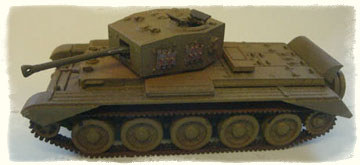
Reviewed in Battlegames No.25 and announced on TMP, RPG Manufacturing Limited are venturing into the Wargaming & Modelmaking arena, with the first of a new range of precision ‘1-piece’ castings that includes several variations on the Cromwell IV and Panzer IV ausf G & H. These models are made by fusing together progressive layers of nylon dust into a 3D model using a CO2 laser (a process called SLS – Selective Laser Sintering). This is somewhat similar (in general terms) to what existing 3D ‘Printers’ do and other similar processes (for example there was an episode in the most recent series of the U.S. show “Bones” that used this technique to recreate a human skeleton from 3D scans). In our case these models are designed in a CAD application, and then scaled to the desired scale (e.g. each RPG Cromwell & Panzer IV are available in 1:100, 1:72, 1:60, 1:56, and 1:48 scale – the models being identical except for their size).
The distinction here is the models have very fine detail, are true 3D (unlike resin and similar which come in parts and often have the back space – such as behind the wheels of the running gear – ‘in-filled’), and are very robust (apparently if you drop them the gun barrels will just flex and bend then spring back straight afterwards, or if you drop something heavy on them they will just flex and pop back into shape whereas a resin or metal kit would break or come-apart). While the initial models are relatively expensive in some scales (e.g. the 1:72 ones are about £25.99 each while the 1:48 ones are as little as £34.50) the point is they are using new cutting edge technology (already used in Medical, Aerospace, Formula One, and similar industries) and will be reliant on future volumes and interest to determine the long-term pricing – it’s my guess this may well be where a lot of the ‘ready-made’ modelling & wargaming market may lead long-term subject to eventual pricing (picture pre-painted versions of these replacing the Dragon, Forces of Valor, Easy Model, and other Die Cast or Ready-Made Plastic models). These are available through Caliver Books and Miniature Figurines, and you can find a list of the initial models and photos at the latter link.
This technology is breakthrough stuff, and where it will really take off is for miniature figurines. While the starting price of an AFV is high, and will depend on how many customers want to buy a specific type of vehicle, there is a much greater volume of sales effect with figures, which will make them more economical to produce than vehicles when using this technology.
Indeed – and even vehicles will reduce in cost as volume increases and such. Imagine what this will be able to do for model ships, planes, guns, etc, as well! 🙂
The other major effect will be on the level of detailing. Theoretically (structural allowances will have to be made for spindly legs and arms in the smaller scales) you will be able to use a 3D template to get exactly the same figure in 1/32nd, 1/72nd, 1/200th, or even 1/300th scale. 1/300th scale figures will be so detailed it will be impossible to see much of the detailing with the naked eye. We’ll need magnifying glasses just to admire the accuracy of such figures.
This technology is breakthrough stuff, and where it will really take off is for miniature figurines. While the starting price of an AFV is high, and will depend on how many customers want to buy a specific type of vehicle, there is a much greater volume of sales effect with figures, which will make them more economical to produce than vehicles when using this technology.
Indeed – and even vehicles will reduce in cost as volume increases and such. Imagine what this will be able to do for model ships, planes, guns, etc, as well! 🙂
The other major effect will be on the level of detailing. Theoretically (structural allowances will have to be made for spindly legs and arms in the smaller scales) you will be able to use a 3D template to get exactly the same figure in 1/32nd, 1/72nd, 1/200th, or even 1/300th scale. 1/300th scale figures will be so detailed it will be impossible to see much of the detailing with the naked eye. We’ll need magnifying glasses just to admire the accuracy of such figures.